Last Updated on October 30, 2023 by Calvyn Ee
Key Points
- September saw promising auto performance despite the UAW strikes, but this might not carry over into October
- The UAW has expanded strikes to a new Ford plant, with a high likelihood the strikes will last longer than was initially expected
- Consumer spending is still fluctuating and may trend lower as they buckle up for the rough times ahead
Despite the UAW strike that’s still happening, it’s still too early to say how much of an impact it will have on the auto industry as a whole. September still saw promising auto sales as consumers are still spending, with light vehicle sales growing 13.9 percent year-over-year to hit a seasonally adjusted annualized rate (SAAR) of 15.7mm units. This would be slightly higher than expected, with estimates going between 15.3mm to 15.4mm units.
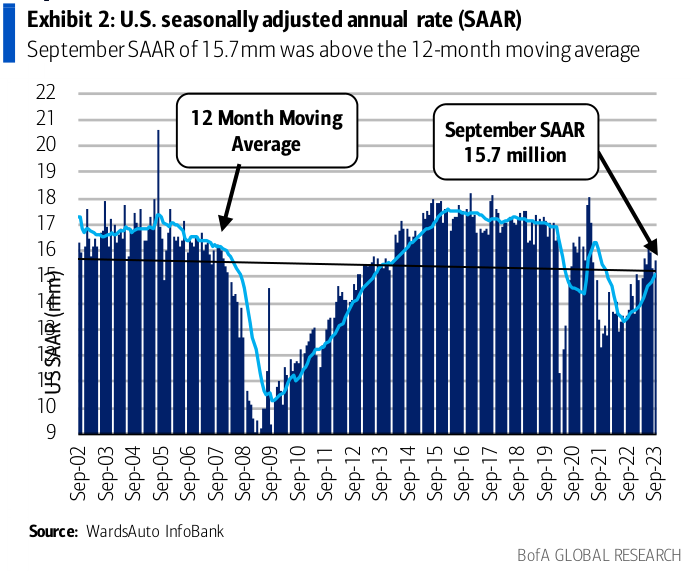
Once again, “strong growth of sales into fleet” helped spur new vehicle sales, marked by a 26 percent increase in sales of large fleets – that’s 154,400 units sold. Fleet market share dropped to 13.8 percent from August’s 15.6 percent but was still slightly higher than last year.
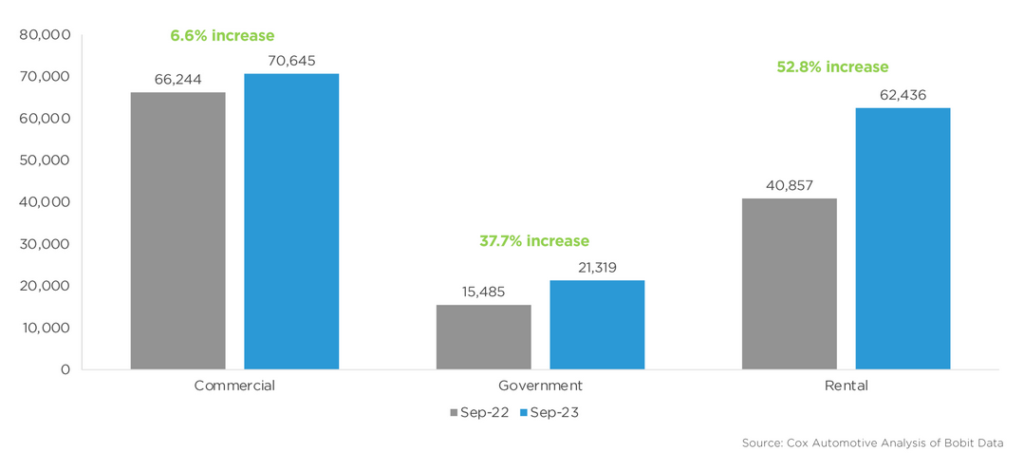
Total inventory at the end of September went up by 137,000 units since the end of August to hit approximately 2.06 million units. Half of the month-over-month increase is attributed to Japanese automakers, with an increase of 72,000 units, while Ford saw an increase of 42,000 units. Comparably, both GM and Stellantis paled in comparison: GM’s inventory was flat, while Stellantis only went up by about 6,000 units. On a days’ supply (DS) basis, inventory stood at 42DS, 3 days higher month-over-month.
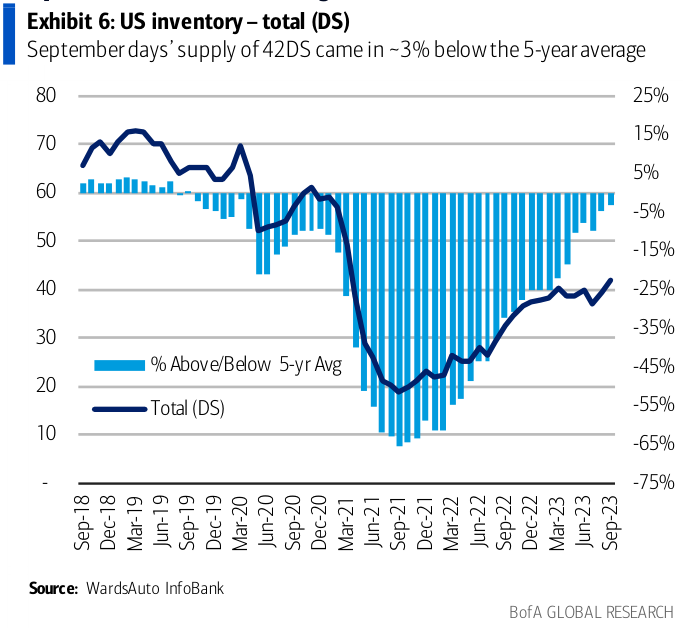
Inventories for most domestic brands – particularly the Detroit Three – were still trending high in September, while Cadillac and Chevrolet continue to have inventory levels below the industry average: Cadillac stands at 46DS while Chevrolet is at 57DS. Meanwhile, Honda, Toyota, and Kia continue to have the lowest inventory levels in the low-to-mid 30s.
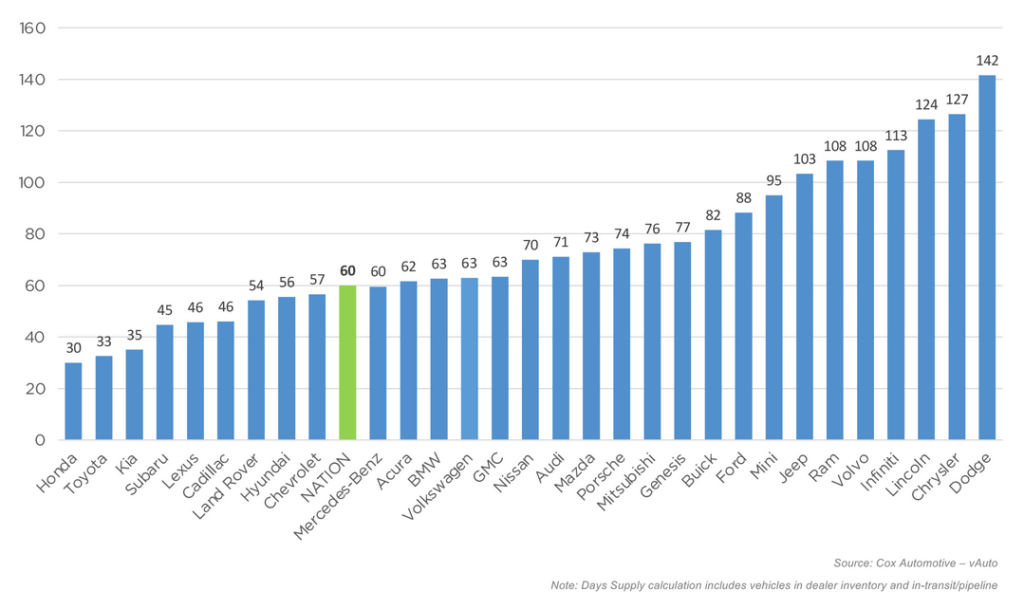
The average transaction price (ATP) for a new vehicle reached $47,899 in September, per Kelley Blue Book, a reduction of $360 from the previous year. Non-luxury vehicle prices went up slightly year-over-year but were down $82 from August. Luxury vehicle prices decreased by $873 from August, driven by Tesla’s aggressive price cut strategy.
Meanwhile, the average listing price of a new vehicle currently stands at $47,397, 3 percent higher than the same period last year. For used cars, the average listing price hovers at $26,717; while slightly higher than it was in August, it’s still 5 percent lower than prices in 2022.
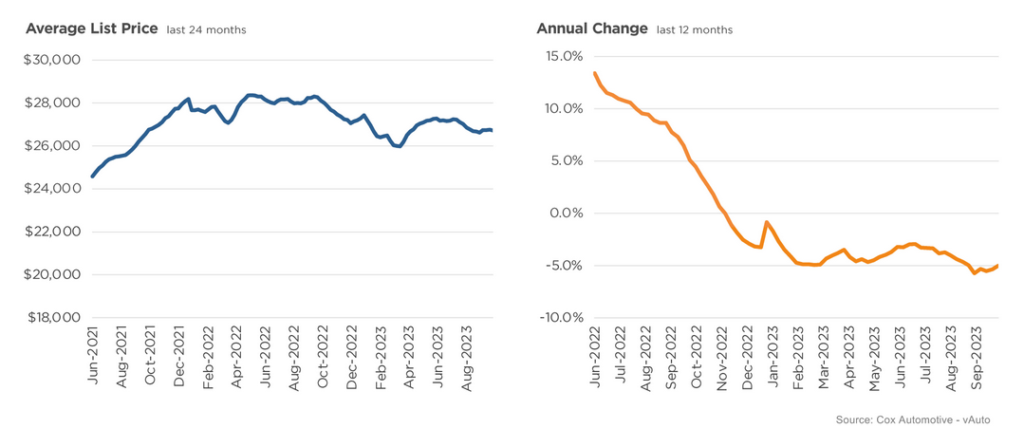
Auto loan availability was also in good shape in September, even though it trended lower to 97.1 in September from August’s 99.1. Credit availability remains mixed, with certified pre-owned (CPO) seeing the most tightening of all credit channels.
EV Sales Still Promising
As reported in Cox Automotive’s Industry Insights and Sales Forecast Call for Q3 2023, US EV penetration is still looking optimistic. The third quarter is set to see EV sales reach “an impressive 308,000 units,” accounting for 8 percent of total vehicle sales. Year-over-year, EV sales have surged over 80 percent and is likely to surpass the 1 million mark by year-end.
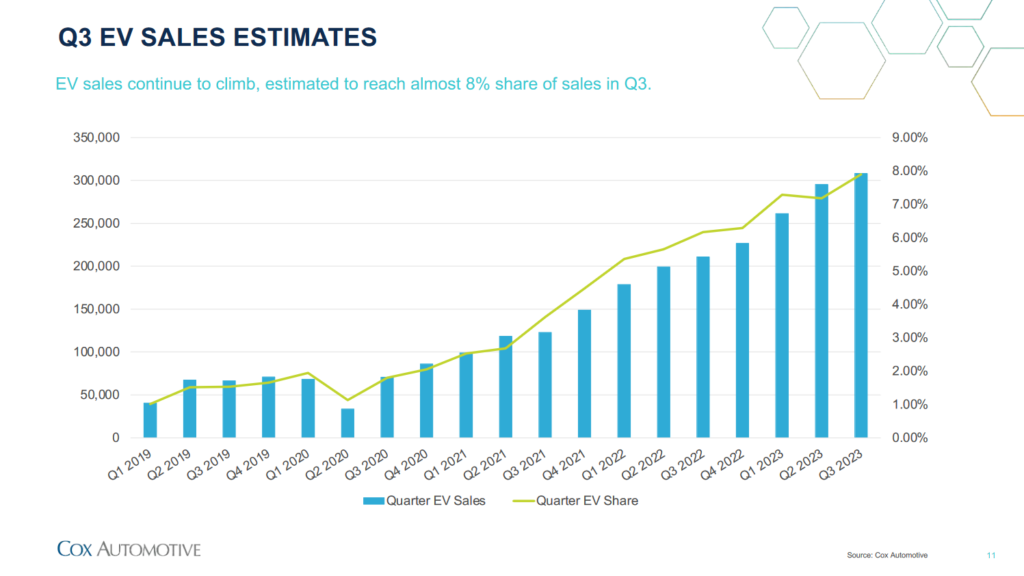
Tesla continues to be a significant force in the EV industry as it keeps outpacing the competition by a huge lead. Nonetheless, rival automakers are still introducing newer EV models; Tesla’s market share has dropped slightly year-over-year while its sales slowed in the third quarter, in part due to “planned downtimes for factory upgrades.”
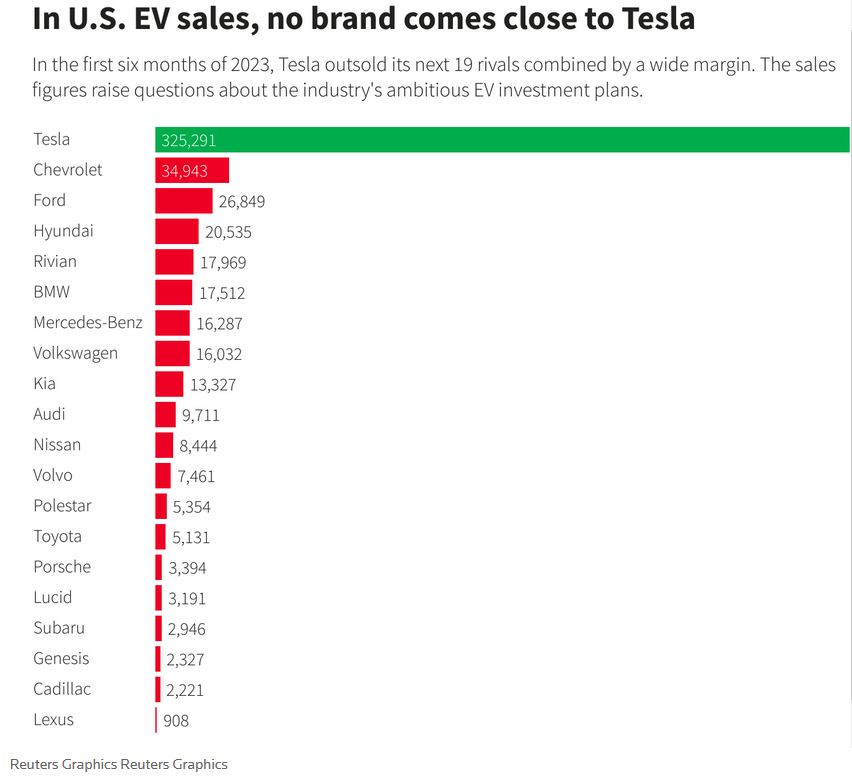
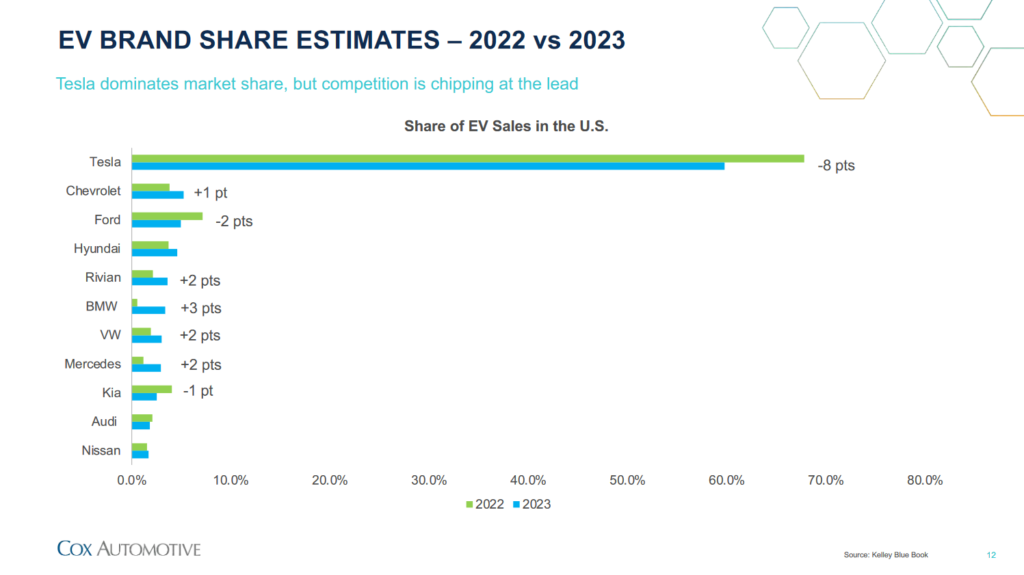
In fact, EV sales growth has largely been benefiting from great supply and more choices available to consumers. As of July 1st this year, 15 new EV models were introduced, allowing consumers to pick from a value-oriented EV that fits their budgetary needs. Meanwhile, the current oversupply of EVs will largely continue into the new year: this does mean there’s more that needs to be sold to consumers, but the silver lining is that the surplus may help to lower prices and increase incentives, making them more attractive to buyers.
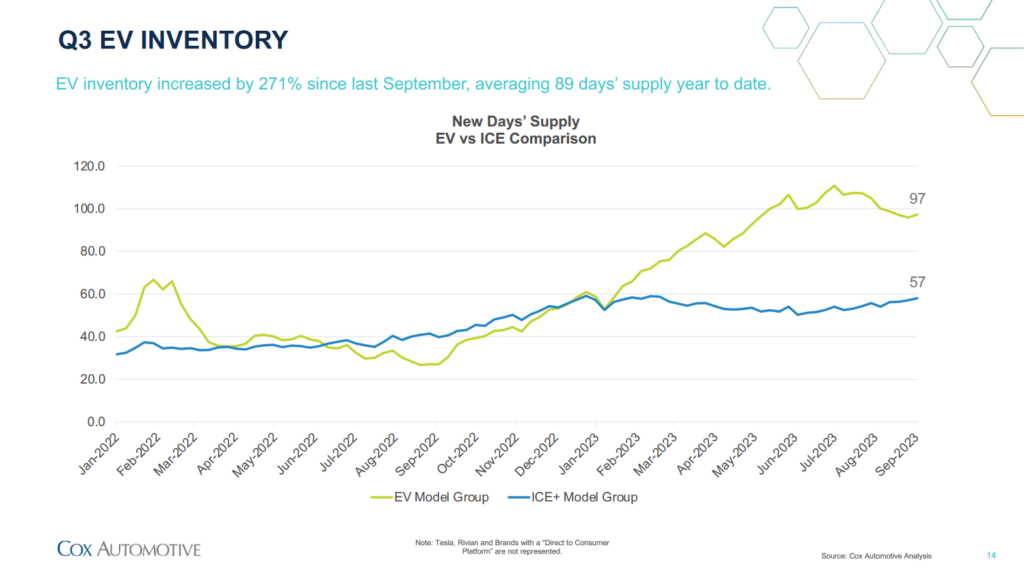
A lot of the gains seen in the industry are thanks to various tailwinds, including government policies, such as the Inflation Reduction Act (IRA) tax credits on EVs, various regulations, such as the California Air Resources Board, and plenty of incentives from dealers and/or automakers.
- More incentives through tax credits or rebates can help ease the financial impact of purchasing an EV. EV prices are still falling, fueled by Tesla’s aggressive price cut campaign, and that will largely benefit consumers in the long term, but this may be disproportionate among income groups
- Improving charging infrastructure may also help increase EV adoption, especially in areas where there’s limited charging infrastructure coverage
- Emissions regulations like those implemented by the California Air Resources Board and its various programs and regulatory actions
- Further promotion and education about the benefits of EVs and their positive impact on the environment may motivate some consumers to buy one
On the subject of pricing, EV prices have gone down 19 percent from over $65,000 last year. As of August, the average price paid for a new EV is $53,376 – down from July’s $53,633 figure. Tesla saw the greatest drop thus far, declining 19.5 percent in August on a year-over-year basis; their popular Model 3’s price decreased more than 21 percent year-over-year.
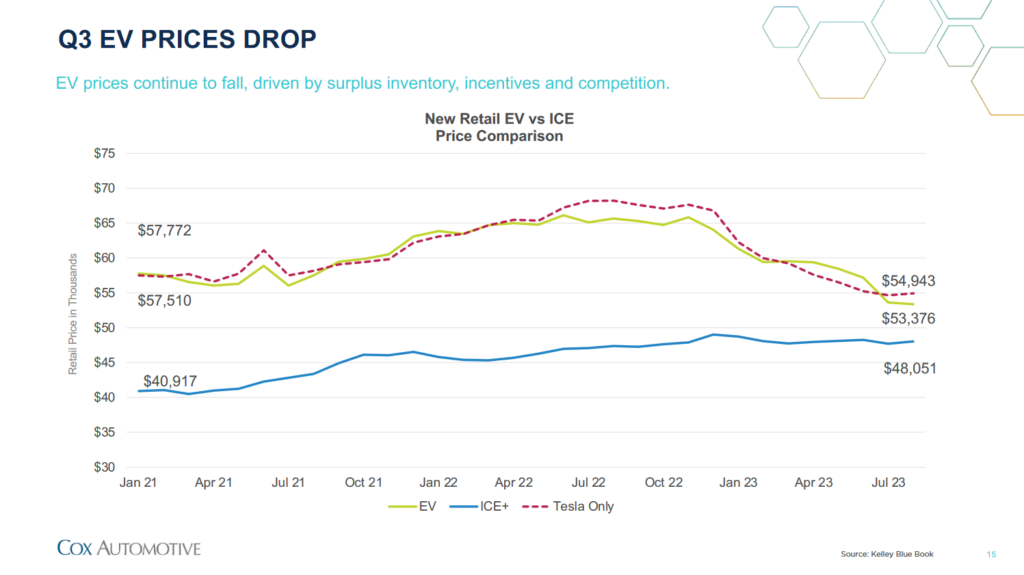
As we said earlier, the excess inventory situation has helped cut EV prices and increase incentives to consumers. On incentives, EVs are among the “highest in the inventory” at 65 percent above the industry average; recent data from Cox Automotive shows that incentives are about 8.1 percent of ATPs – a significant increase from last year’s paltry 1.6 percent figure.
An increase in EV leasing also showed promise, helped largely by a loophole in IRA tax credits when buyers lease an EV not made in North America. As of August, EV leasing was up 24 percent compared to 20 percent for all vehicle leasing. From December 2022 to August this year, EV leasing increased by 53 percent.
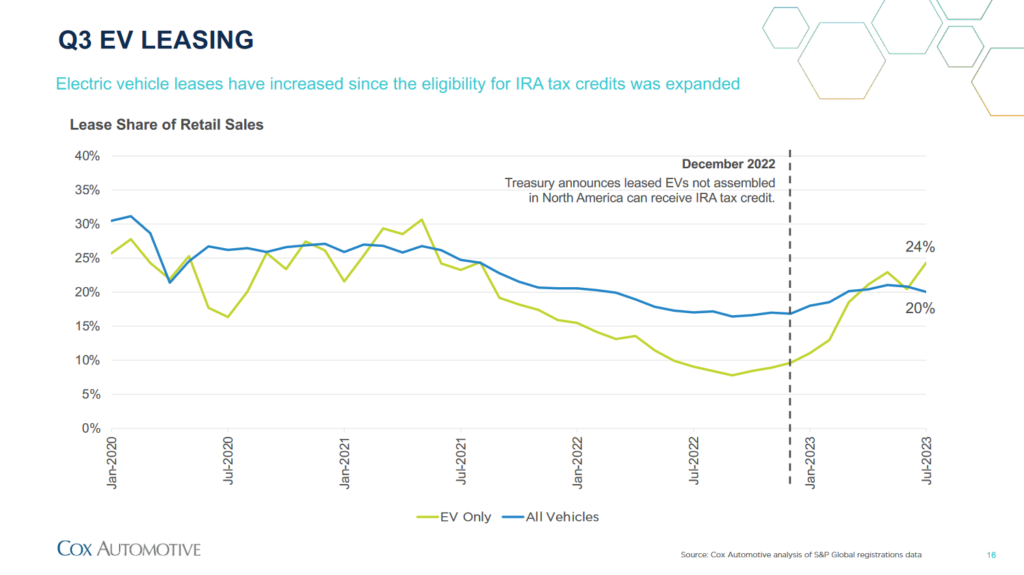
The UAW Impact
There’s still a great deal of uncertainty in spite of the gains we’ve seen in the auto industry, largely due to the long-term impact the UAW strikes will have as a whole. While the largest impact would not doubt be to the Detroit Three, especially if the UAW continues with targeted strikes to other locations, there could be both pros and cons to the industry as a whole. Alternatively, nothing really changes beyond the Detroit Three losing some profits.
Where the Detroit Three are languishing with factory shutdowns due to the strikes, other automakers stand to gain substantially. Demand for Detroit Three inventories will still be doing well in October but may be in trouble once supply starts to dwindle. Most of their inventories are hovering above 80DS except for Cadillac (46DS), Chevrolet (57DS), and GMC (63DS) – all in preparation for the strikes.
The most notable impact the strikes are having is the Detroit Three’s inability to manufacture new cars to meet consumer demand. With workers actively striking, the Detroit Three have collectively laid off approximately 5,000 or so auto workers, a move Ford claims is an “unfortunate result of the UAW’s strategy.” This is said to be far less than if the UAW had all its members walk out for the strike: the UAW’s adoption of a stand-up strike, where only certain union members at chosen locations would strike, may have had a hand in this.

The resulting drop in productivity will mean that the Detroit Three have to consider canceling orders with suppliers if the going gets tough. That can have profound “ripple effects” on the suppliers and their workforce. Suppliers will do their best to prevent layoffs from happening, partly in fear that they won’t be able to rehire, but if push comes to shove, they’ll have no other choice but to cut losses.
As it is, Ford has already canceled dealer stock orders of its 2023 F-150 Lightning as part of “additional quality checks” that were needed. Whether this is due to the UAW strikes or the battery issues plaguing the Lightning isn’t clear.
Once supply begins to reduce, the price drops we’ve seen (small though they were) may soon come to an end as the Detroit Three desperately hold on to their remaining inventories. This might not reflect on the rest of the auto industry, however, as other automakers are still having fairly good inventory levels. Over-performers like Honda and Toyota, however, remain tight to this day.
The supply chain disruptions will also affect repair shops, who are now worried this will drive down business. In an interview with CBS News, service manager Dave Peske of Wetmore’s Tire and Auto in Ferndale, Michigan, summarized the problem at hand: “If the dealers don’t have the parts, then the customers aren’t going to get their cars fixed.”
Now that the UAW has expanded the strikes to Ford’s Kentucky Truck Plant, it seems clear that the UAW will persist with the strikes until a fair deal can be reached with the Detroit Three. Just the previous week, an expansion of the strikes was averted when GM conceded to one of the UAW’s terms – that being “workers at [GM’s] future EV battery plants [will] be covered by the national labor agreement governing other UAW members at GM.”
In the meantime, Ford has criticized the UAW’s newest move, calling it “grossly irresponsible” while claiming that “Ford is the only automaker to add UAW jobs since the Great Recession.” Thus far, the strikes have caused the manufacturers an estimated $2.68 billion in losses, and that will gradually increase the longer it goes.
Heed the Warning Signs
Even as the UAW strikes go on, the fluctuating consumer spending situation may soon be coming to a head: prices continue to rise, inflation remains sticky, and higher inflation rates lead to more loan delinquencies, especially auto loans.
The strikes could still potentially impact car prices, with used cars being the first to be hit since dealers cannot charge above MSRPs, with some estimates suggesting prices can go up 10 percent if the strike lasts 40 days.
“We’ll likely start seeing the first signs of real impact in October and if disruption continues, the impacts will cascade into the used market as well.”
Jonathan Smoke, Chief Economist of Cox Automotive
Again, the Detroit Three’s losses can mean gains for its rivals, especially in the wake of Tesla’s aggressive price cuts that could possibly continue to regain its EV market share. While it’s quite unlikely, Tesla’s determination to boost sales has clearly been seen since the start of the year.
Car buyers will no doubt head out early to find the best deals before prices inextricably rise, and the option to go with used cars is looking a little more confident now that prices have normalized to an extent. Even so, the parts situation is also looking grim because of the strikes, which can be really bad news for car owners nationwide. Independent shops might fare well, but cars that require specific manufacturer-made parts may be in trouble if anything were to happen.
Just as concerning is that “auto loan debt has outpaced student loan debt,” according to Experian, the first time it’s happened since 2010. Experian found that “30-day delinquencies increased to 2.72% in the second quarter of 2023, surpassing pre-COVID levels.” This puts a significant number of car owners at risk of repossession if they’re unable to meet their financial obligations.
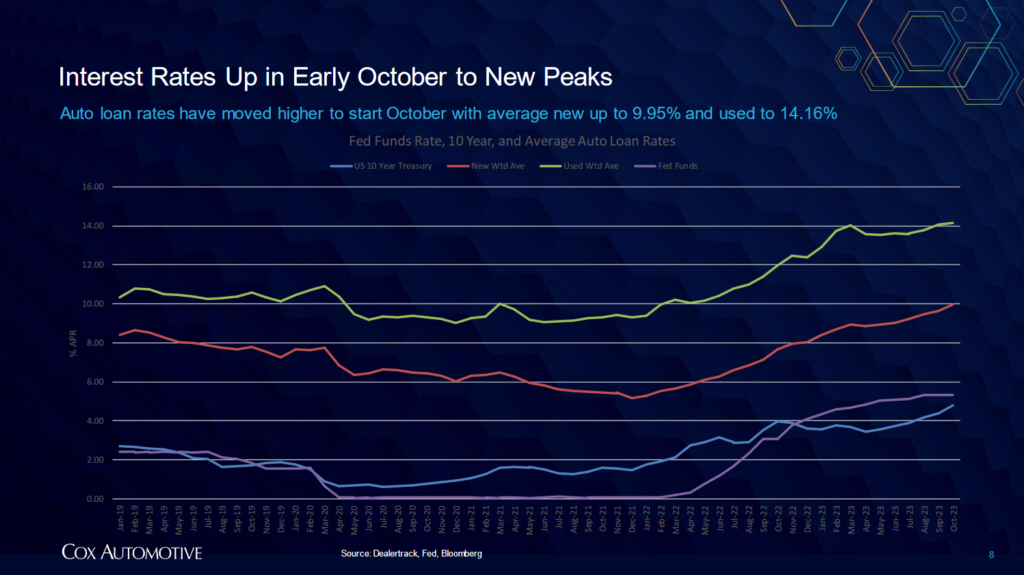
Waning consumer confidence is also indicative of consumers being more aware that times are tough and they’d have to do what they can to stretch their dollars. Consumer spending did see a minor increase in September, but whether that will carry over into October remains to be seen. So far, the signs are pointing toward more frugal spending patterns – which could mean waning future vehicle purchases.
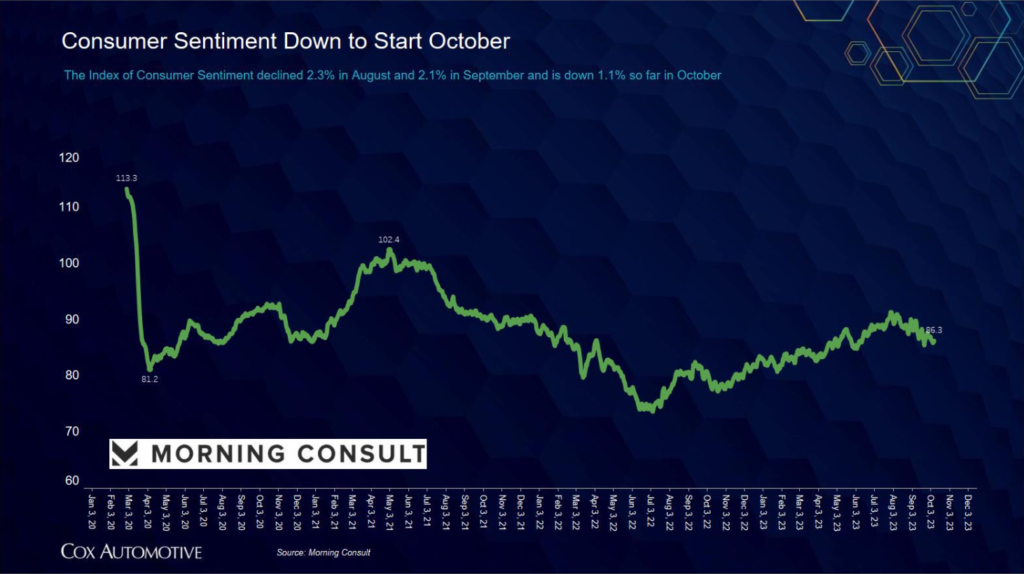
The further tightening of auto loans by Teachers Federal Credit Union and GreenState Credit Union, on top of Ally Bank – a major auto loan player – laying off staff, are also indicators of tough times ahead for the auto industry as a whole. Tighter auto loans mean that car buyers will have a hard time getting financing, while staff reductions are pointing to weaker profitability as consumer spending shrinks.
And that’s just the tip of the iceberg.




